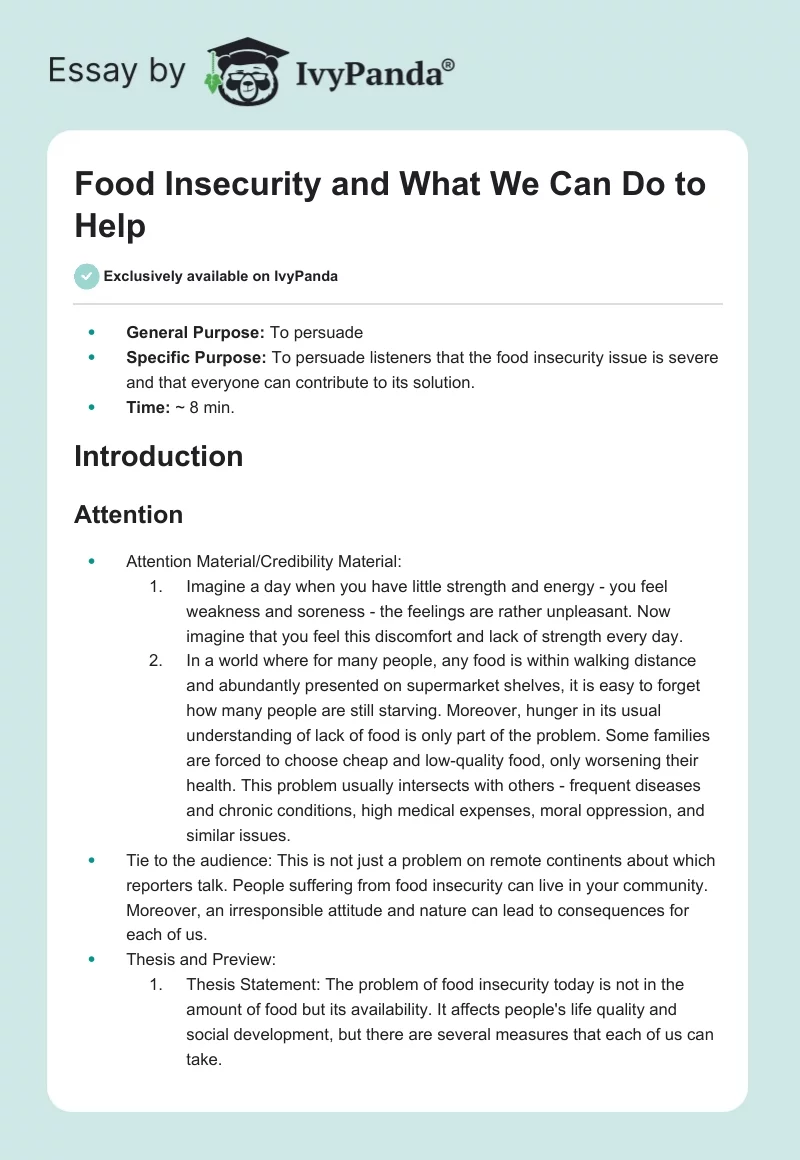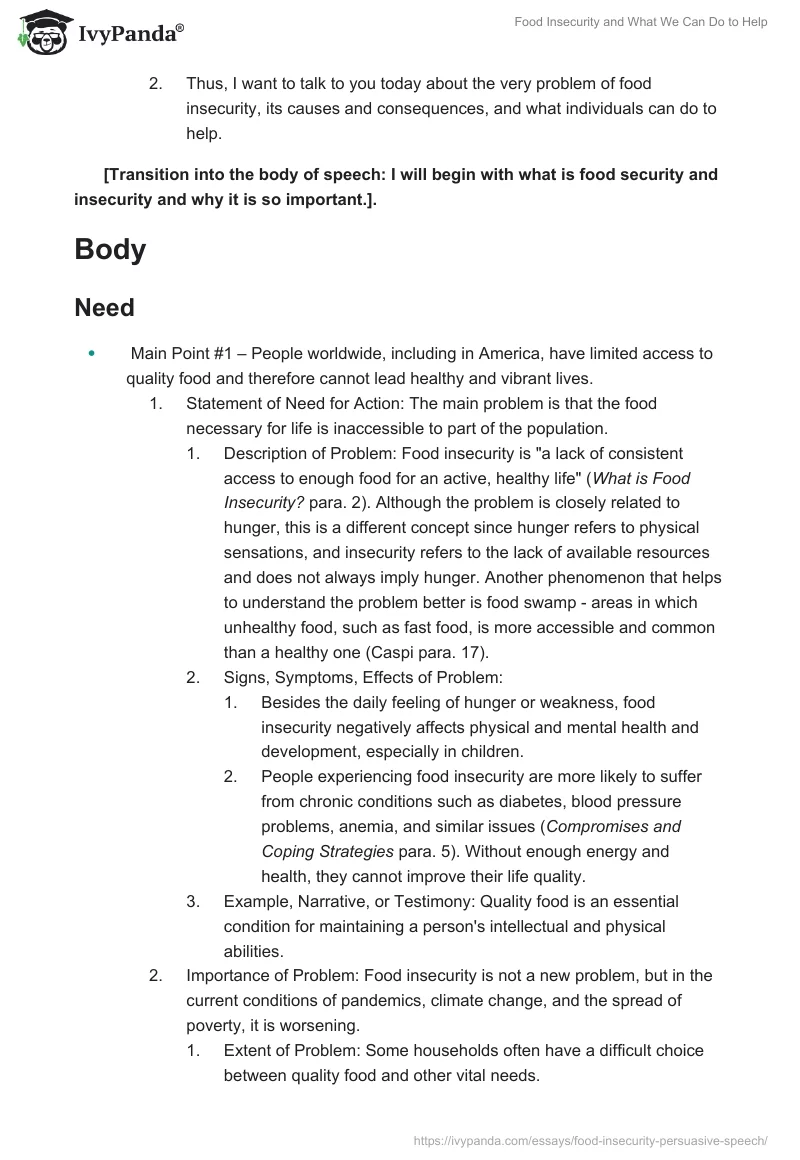- General Purpose: To persuade
- Specific Purpose: To persuade listeners that the food insecurity issue is severe and that everyone can contribute to its solution.
- Time: ~ 8 min.
Introduction
Attention
- Attention Material/Credibility Material:
- Imagine a day when you have little strength and energy – you feel weakness and soreness – the feelings are rather unpleasant. Now imagine that you feel this discomfort and lack of strength every day.
- In a world where for many people, any food is within walking distance and abundantly presented on supermarket shelves, it is easy to forget how many people are still starving. Moreover, hunger in its usual understanding of lack of food is only part of the problem. Some families are forced to choose cheap and low-quality food, only worsening their health. This problem usually intersects with others – frequent diseases and chronic conditions, high medical expenses, moral oppression, and similar issues.
- Tie to the audience: This is not just a problem on remote continents about which reporters talk. People suffering from food insecurity can live in your community. Moreover, an irresponsible attitude and nature can lead to consequences for each of us.
- Thesis and Preview:
- Thesis Statement: The problem of food insecurity today is not in the amount of food but its availability. It affects people’s life quality and social development, but there are several measures that each of us can take.
- Thus, I want to talk to you today about the very problem of food insecurity, its causes and consequences, and what individuals can do to help.
[Transition into the body of speech: I will begin with what is food security and insecurity and why it is so important.].
Body
Need
- Main Point #1 – People worldwide, including in America, have limited access to quality food and therefore cannot lead healthy and vibrant lives.
- Statement of Need for Action: The main problem is that the food necessary for life is inaccessible to part of the population.
- Description of Problem: Food insecurity is “a lack of consistent access to enough food for an active, healthy life” (What is Food Insecurity? para. 2). Although the problem is closely related to hunger, this is a different concept since hunger refers to physical sensations, and insecurity refers to the lack of available resources and does not always imply hunger. Another phenomenon that helps to understand the problem better is food swamp – areas in which unhealthy food, such as fast food, is more accessible and common than a healthy one (Caspi para. 17).
- Signs, Symptoms, Effects of Problem:
- Besides the daily feeling of hunger or weakness, food insecurity negatively affects physical and mental health and development, especially in children.
- People experiencing food insecurity are more likely to suffer from chronic conditions such as diabetes, blood pressure problems, anemia, and similar issues (Compromises and Coping Strategies para. 5). Without enough energy and health, they cannot improve their life quality.
- Example, Narrative, or Testimony: Quality food is an essential condition for maintaining a person’s intellectual and physical abilities.
- Importance of Problem: Food insecurity is not a new problem, but in the current conditions of pandemics, climate change, and the spread of poverty, it is worsening.
- Extent of Problem: Some households often have a difficult choice between quality food and other vital needs.
- Facts/Statistics:
- According to the United Nations, the number of people suffering from the problem in the world reaches 690 million inhabitants, or almost 9% (Goal 2: Zero Hunger para. 1).
- In America, one in nine citizens experience food insecurity problems, equating to 37 million people, of which 11 million are children (What is Food Insecurity? para. 1).
- More than 60% of American citizens facing food insecurity are forced to choose between food and utilities, healthcare, or transportation (Compromises and Coping Strategies para 2). To save money, about 80% of affected people choose unhealthy food (Compromises and Coping Strategies para. 4).
- At the same time, about 1.3 billion tonnes of food, a third of all food produced for people, is wasted every year (Depta para. 2).
- Who is Affected: Food insecurity can affect adults, children, people of different nationalities – all low-income citizens. It can be caused by economic instability, extreme weather events such as drought or flooding, armed conflicts, and similar problems (Global Report on Food Crises 2021 para. 2-3).
- Statement of Need for Action: The main problem is that the food necessary for life is inaccessible to part of the population.
Example/Narrative and/or Facts/Statistics: Nevertheless, the representation of the problem reflects the general picture of the population – African Americans and Hispanics suffer more (Caspi para. 14). Injustice is associated with general discriminatory practices and their consequences – difficulties accessing opportunities, lack of affordable housing, and other problems.
[Transition: As you can see, the reasons for food insecurity are deep, and states should devote part of their activities to its solution. However, each person can also take several measures to help improve the situation.]
Satisfaction
- Main Point #2 – Present Solution that Satisfies Need: Individuals can take care of nature, control the level of consumption and participate in charity.
- Description of Solution: Even a small personal contribution may affect the global situation.
- How Solution Satisfies Need: A responsible attitude towards the environment will slow climate change, giving time to solve problems in the long term. Charity will have an effect in the short term, as it will provide the necessary resources to those who need them.
- How Solution can be Implemented: To take action, you need awareness of the problem and solutions and participation in charitable organizations’ work.
- Plan of Action:
- Step 1 of Plan: Responsible attitude to the environment involves recycling, not pollution of nature, saving natural resources, and similar measures that everyone can learn.
- Step 2 of Plan: It is necessary to prevent the excessive purchase of food and its throwing out by planning meals and supporting local producers.
- Step 3 of Plan: Participation in charity can be different – volunteering or making donations. You only need to find suitable initiatives in your area using the Internet.
- Description of Solution: Even a small personal contribution may affect the global situation.
[Transition: Thus, you can start solving global problems with small steps but achieve great results.]
Visualization
- Main Point #3 – Visualize Results: Efforts to address food insecurity also contribute to the related issues – environmental protection, inequality, and poverty.
- Describe Expected Results of Action: The more people learn about the problem and take action, the greater their effect. In particular, responsible food consumption and the purchase will reduce surplus production and use resources in less affluent areas. Taking care of the environment will also slow climate change. Finally, helping people get the nutrition necessary for a healthy life will improve the nation’s health and well-being.
- Describe Consequences of Inaction: If the problem is ignored, the number of people who do not receive the necessary nutrition will increase. Their oppressed condition will prevent them from showing their potential and talents and investing it in the development of society. Moreover, we contribute to inequality, discrimination, environmental degradation, and other related issues by ignoring the problem.
Conclusion
[Transition: In conclusion]
Action
- Brakelight: In conclusion, as you see, the solution to global problems is the shared responsibility of each of us.
- Summary: I provided to you information about what food insecurity is, its danger, the reasons, and how to deal with it. The inaccessibility of quality food negatively affects people’s health and well-being and can be triggered by poverty, environmental disasters, inequality, and other causes.
- Tie Back to the Audience: Although it may seem that the responsibility lies with others – politicians, corporations, international organizations, everyone makes a choice – whether or not to help.
- Concluding Remarks:
CALL TO ACTION: I encourage you to be responsible in your lifestyle, help others and take care of your health.
Works Cited
Caspi, Caitlin. “What is Food Insecurity?”The Conversation, 2021, Web.
“Compromises and Coping Strategies.”Feeding America, Web.
Depta, Laura. “Global Food Waste and its Environmental Impact.”Reset, 2018, Web.
“Global Report on Food Crises 2021.”Reliefweb, 2021, Web.
“Goal 2: Zero Hunger.”United Nations, Web.
“What is Food Insecurity?”Hunger + Health, Web.


